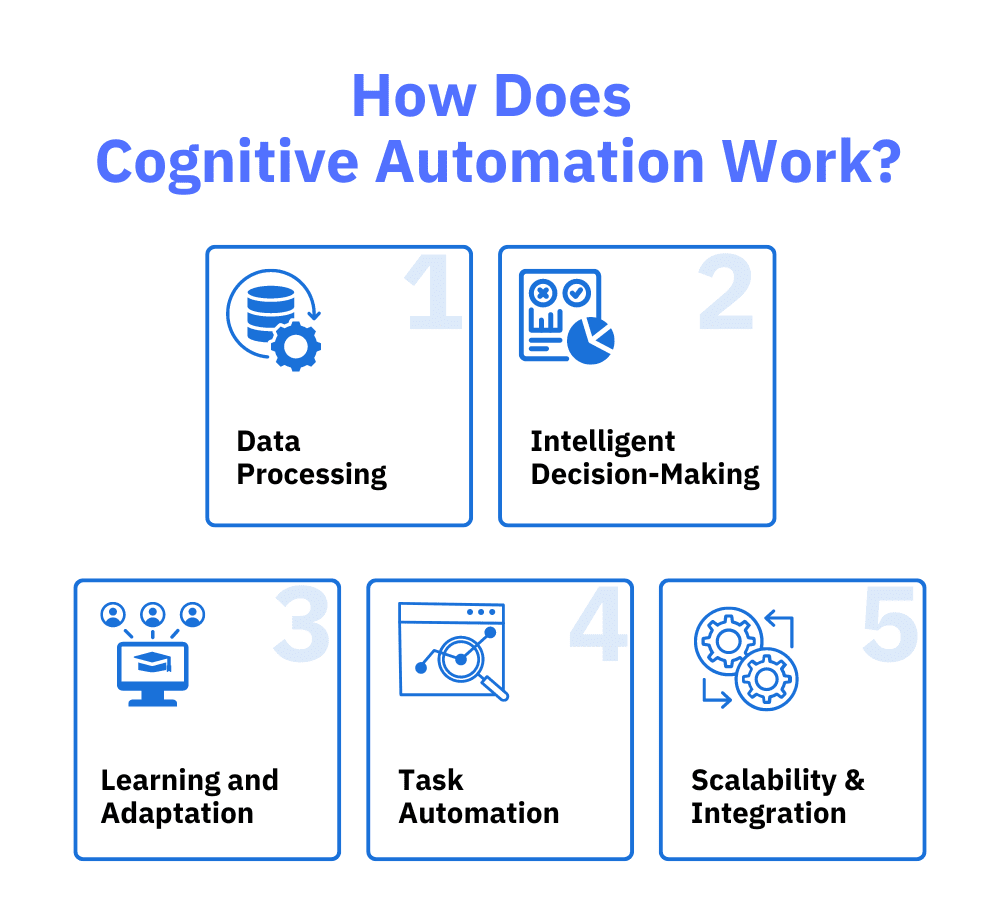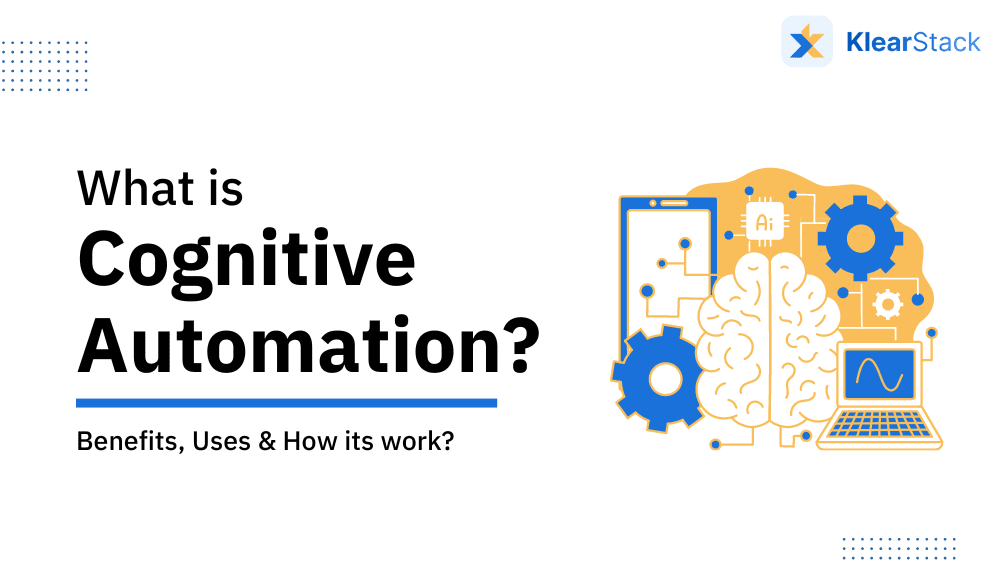What is Cognitive Automation
Cognitive automation is the strategic integration of artificial intelligence (AI) and process automation, aimed at enhancing business outcomes. It encompasses many techniques like Natural Language Processing (NLP), Machine Learning (ML), Robotic Process Automation (RPA), Cognitive Computing, Computer Vision, and Predictive Analytics, that empower automation to efficiently capture, utilize & analyze data.
Through this data analysis, cognitive automation facilitates more informed and intelligent decision-making, leading to improved strategic choices and outcomes. It streamlines operations, reduces manual effort, and accelerates task completion, thus boosting overall efficiency.
Example of Cognitive Automation
An example of cognitive automation is in the field of customer support, where a company uses AI-powered chatbots to provide assistance to customers.
Consider you’re a customer looking for assistance with a product issue on a company’s website. You start a chat conversation. Instead of waiting for a human agent, you’re greeted by a friendly virtual assistant. This assistant is basically a chatbot that understands your queries. They’re phrased informally or with specific industry jargon, making you feel understood and supported.
These chatbots are equipped with natural language processing (NLP) capabilities, allowing them to interact with customers, understand their queries, and provide solutions.
How Does Cognitive Automation Work?
Cognitive automation works by combining the power of artificial intelligence (AI) and automation to enable systems to perform tasks that typically require human intelligence. It analyzes data, learns patterns, and applies logic to perform tasks.

This technology uses algorithms to interpret information, make decisions, and execute actions to improve efficiency in various business processes. Here’s an overview of how cognitive services work.
#1. Data Processing
Cognitive process automation starts by processing various types of data, including text, images, and sensor data, using techniques like natural language processing and machine learning.
#2. Intelligent Decision-Making
It uses AI algorithms to make intelligent decisions based on the processed data, enabling it to categorize information, make predictions, and take actions as needed.
#3. Learning and Adaptation
The system continuously learns from its interactions and data inputs, improving its decision-making abilities and becoming more efficient over time.
#4. Task Automation
Once the system has made a decision, it automates tasks such as report generation, data entry, and even physical processes in industrial settings, reducing the need for manual intervention.
#5. Scalability and Integration
It can seamlessly integrate with existing systems and software, allowing it to handle large volumes of data and tasks efficiently, making it suitable for businesses of varying sizes and needs.
Top 5 Benefits of Cognitive Automation
The benefits of cognitive process automation are numerous and can significantly impact businesses and organizations.

Here are some key advantages:
1. Enhanced Efficiency
Cognitive automation streamlines operations by automating repetitive tasks, quicker task completion and freeing up human for more complex roles. This efficiency boost results in increased productivity and optimized workflows.
2. Improved Decision-Making
Ability to analyze large datasets quickly, cognitive automation provides valuable insights, empowering businesses to make data-driven decisions. This leads to better strategic planning, reduced risks, and improved outcomes.
3. Error Reduction and Increased Accuracy
By automating tasks that are prone to human errors, cognitive automation significantly reduces mistakes, ensuring consistently high-quality output. This is particularly crucial in sectors where precision are paramount, such as healthcare and finance.
4. Cost Savings and Resource Optimization
Automation of various tasks helps businesses to save cost, reduce manual labor, optimize resource allocation, and minimize operational expenses. This cost-effective approach contributes to improved profitability and resource management.
5. Improved Customer Experience
Cognitive automation enhances the customer experience by providing accurate responses, round-the-clock support, and personalized interactions. This results in increased customer satisfaction, loyalty, and a positive brand image, ultimately leading to business growth and a competitive advantage in the market.
Uses of Cognitive Automation
- Data Analysis and Interpretation
For professionals handling complex data sets, cognitive automation simplifies the process by:
- Swiftly processing data,
- Providing actionable insights,
- Supporting informed decision-making,
- Allowing them to focus on strategic initiatives.
- Customer Service and Support
For customers seeking assistance, cognitive automation creates a seamless experience with intelligent chatbots and virtual assistants. It ensures accurate responses to queries, providing personalized support, and fostering a sense of trust in the company’s services.
- Workflow Optimization
Within a company, cognitive process automation streamlines daily operations for employees by automating repetitive tasks. It enables smoother collaboration between teams, and enhancing overall workflow efficiency, resulting in a more productive work environment.
- Risk Management and Compliance
In sectors with strict regulations, such as finance and healthcare, cognitive automation assists professionals by identifying potential risks. It ensures compliance with industry standards, and providing a reliable framework for handling sensitive data, fostering a sense of security among stakeholders.
- Predictive Maintenance
For maintenance professionals in industries relying on machinery, cognitive automation predicts maintenance needs. It minimizes equipment downtime, optimizes performance, and allowing teams to proactively address issues before they escalate. It leads to increased operational reliability and cost savings.
Differences Between RPA and Cognitive Automation
RPA and Cognitive Automation differ in terms of, task complexity, data handling, adaptability, decision-making abilities, & complexity of integration.
Task Complexity
RPA focuses on automating rule-based, repetitive tasks, while cognitive services handle more complex and cognitive tasks that involve data analysis, decision-making, and learning.
Data Handling
RPA primarily deals with structured data and predefined rules, whereas cognitive automation can handle unstructured data, making sense of it through natural language processing and machine learning.
Adaptability
While RPA systems follow predefined rules and instructions, cognitive automation solutions can learn from data patterns, adapt to new scenarios, and make intelligent decisions, enhancing their problem-solving capabilities.
Decision-Making Abilities
RPA is limited to executing preprogrammed tasks, whereas cognitive automation can analyze data, interpret information, and make informed decisions, enabling it to handle more complex and dynamic tasks.
Complexity of Integration
RPA is relatively easier to integrate into existing systems and processes, while cognitive process automation may require more complex integration due to its advanced AI capabilities and the need for handling unstructured data sources.

Ready to Take Your Automation to the Next Level?
KlearStack is a hassle-free solution to a reliable automation experience.
✓ Achieve 99% accuracy,
✓ Reduce costs by up to 70%
✓ Effortless integration with tools like RPA, ERP, CRM, etc
Don’t wait—Schedule a demo session today!
FAQs on Cognitive Automation
Cognitive automation examples include AI-driven chatbots for customer support, data analysis for decision-making, and automated document processing, enhancing operational efficiency across various industries and facilitating personalized customer interactions.
It is used to streamline operations, improve decision-making, and enhance efficiency through the integration of AI technologies, leading to optimized workflows, reduced manual effort, and a more agile response to dynamic market demands.
Cognitive automation in RPA refers to the integration of advanced AI capabilities, such as natural language processing and machine learning, within robotic process automation systems, enabling more intelligent and adaptable automation solutions that can handle complex and unstructured data.
The key difference lies in capabilities: RPA focuses on automating rule-based, repetitive tasks, while cognitive automation leverages AI for data analysis, and decision-making, enabling more complex and adaptive automation processes with cognitive capabilities. It ultimately leads to more sophisticated automation solutions.






